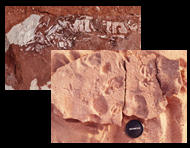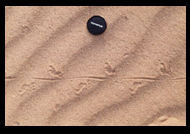|
|
||
|
| ||
|
Dr. Kevin Padian studies how large-scale changes get started in evolution. To address questions such as “how did flight evolve?” and “how did dinosaurs walk?” he and his students examine fossil evidence and make functional analogies between extinct species and modern vertebrates. Padian and his students are careful to frame this work within the context of the evolutionary relationships among the groups under study.
“Usually we think of diverse groups of organisms as being tied to new, exciting adaptations. The evolution of those adaptations usually happens quickly, and from then on, there’s a lot of fine tuning within the new, successful group,” he explains. “The neat thing is to go back to the beginning, to look at the close relatives of this new group, and see how the adaptation assembled piece by piece. We can combine functional analysis with our understanding of evolutionary relationships to generate some strong testable hypotheses about how existing structures and functions are modified for new roles.” Padian has used this approach to study how birds first started to fly. Using a phylogenetic framework, he has been working out the sequence of evolutionary events leading up to powered flight in dinosaurs and birds. “It’s very difficult to fly because your structures, your movement, and your energetics have to be so closely attuned to flight. To see the sequence of changes, for example, in the evolution of dinosaurs closest to the origin of birds is really amazing.” Padian also works on the transition from the Triassic to the Jurassic Period and the changes in land-dwelling vertebrates associated with this time period. He has collaborated in a number of functional studies looking at the footprints left by different kinds of reptiles, research that has implications on how fossil footprints are interpreted, especially with respect to reconstructing dinosaur foot shape. According to Padian, “Locomotion is one thing that separates dinosaurs and their relatives from other reptiles.” He believes that fossil footprints can provide important information about evolutionary changes that occurred during “The Age of Dinosaurs.”
|
|
| Browse the Interview: Profile | Fossil Protection | Career | ||
| Home | What’s new | About UCMP | History of life | Fossil collections | Other resources | ||


